mytest
eBooks, Books, and more from ARUDOU, Debito (click on icon):
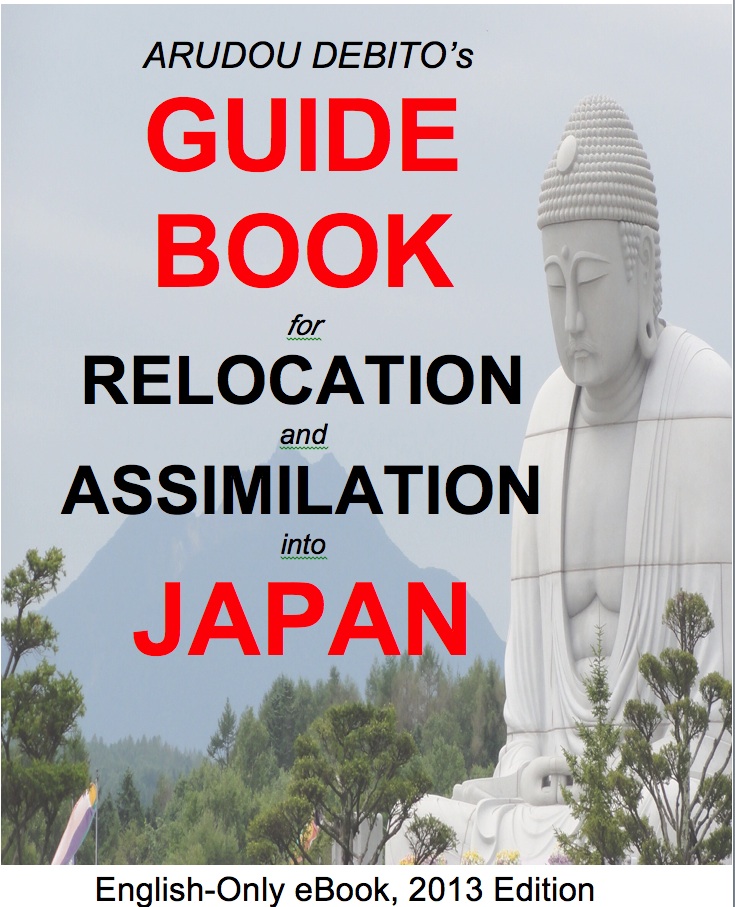
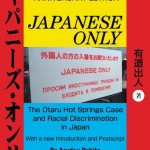
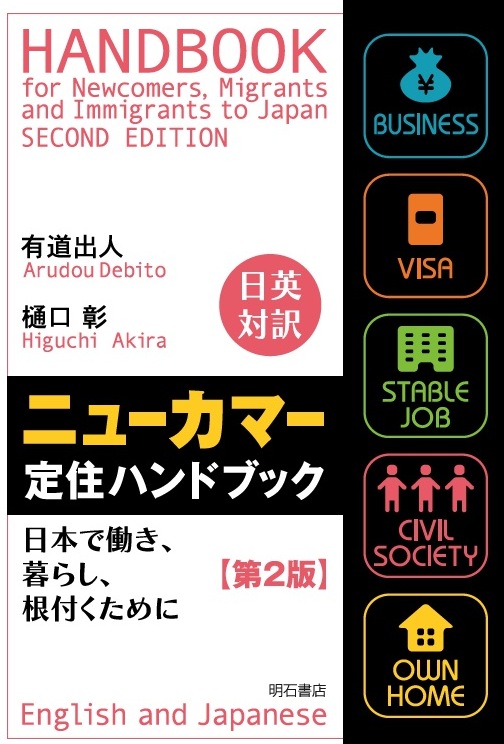
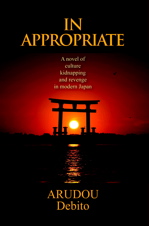

![]()


UPDATES ON TWITTER: arudoudebito
DEBITO.ORG PODCASTS on iTunes, subscribe free
“LIKE” US on Facebook at http://www.facebook.com/debitoorg
http://www.facebook.com/handbookimmigrants
https://www.facebook.com/JapaneseOnlyTheBook
https://www.facebook.com/BookInAppropriate
If you like what you read and discuss on Debito.org, please consider helping us stop hackers and defray maintenance costs with a little donation via my webhoster:

All donations go towards website costs only. Thanks for your support!
Hello Blog. Japan, after years of pressure from overseas, is now a signatory to the Hague Convention on the Civil Aspects of International Child Abduction, where children of international marriages are to be protected against psychologically-damaging abductions and severed contact with one parent after marriage dissolution and divorce. Debito.org has covered this issue extensively in the past. What matters now is how Japan intends to enforce the treaty. Debito.org has argued that we are not hopeful about Japan following the spirit of the agreement in good faith. It has been reinterpreting sections with caveats to give the Japanese side undue advantages in negotiations, indirectly portraying the Non Japanese (NJ) party as the suspicious interloper, redefining important issues such as domestic violence (DV) to include heated arguments and “silent stares” etc., refusing to see abductions by the Japanese parent as much more than a natural repatriation, and not being self-aware that in Japan, child abduction and severed contact with one parent is quite normal (due in part to the vagaries of the Family Registration System (koseki)), but not necessarily in the best interests of the child. Japan has been, in short, a haven for international child abductions, and how the GOJ will interpret the Hague to its people is crucial for change in public mindsets and enforcement.
To that end, Debito.org is fortunate to have received a copy from a concerned reader of a 2014 Ministry of Foreign Affairs (Gaimushou) pamphlet explaining the Hague to the Japanese public. Scanned below in full, within its discourse are troubling assumptions and presumptions that bear scrutiny and exposure, as they remain along the lines of the concerns expressed above. If this is Japan’s official mindset towards international child abductions, then Debito.org remains pessimistic, if not cynical, about Japan’s intentions to enforce the Hague in good faith. Dr. ARUDOU, Debito
UPDATE, courtesy of Debito.org Reader Oliver: The pamphlet can be found on the MOFA website, so it is genuine. PDF is here:
http://www.mofa.go.jp/mofaj/files/000033409.pdf
(link from this page: http://www.mofa.go.jp/mofaj/gaiko/hague/index.html)
And there is even an English language version!
http://www.mofa.go.jp/files/000034153.pdf
(link from this page: http://www.mofa.go.jp/fp/hr_ha/page22e_000249.html)
From the Japanese Consulate in Hong Kong, courtesy of XY.
(click on any image to expand in browser)
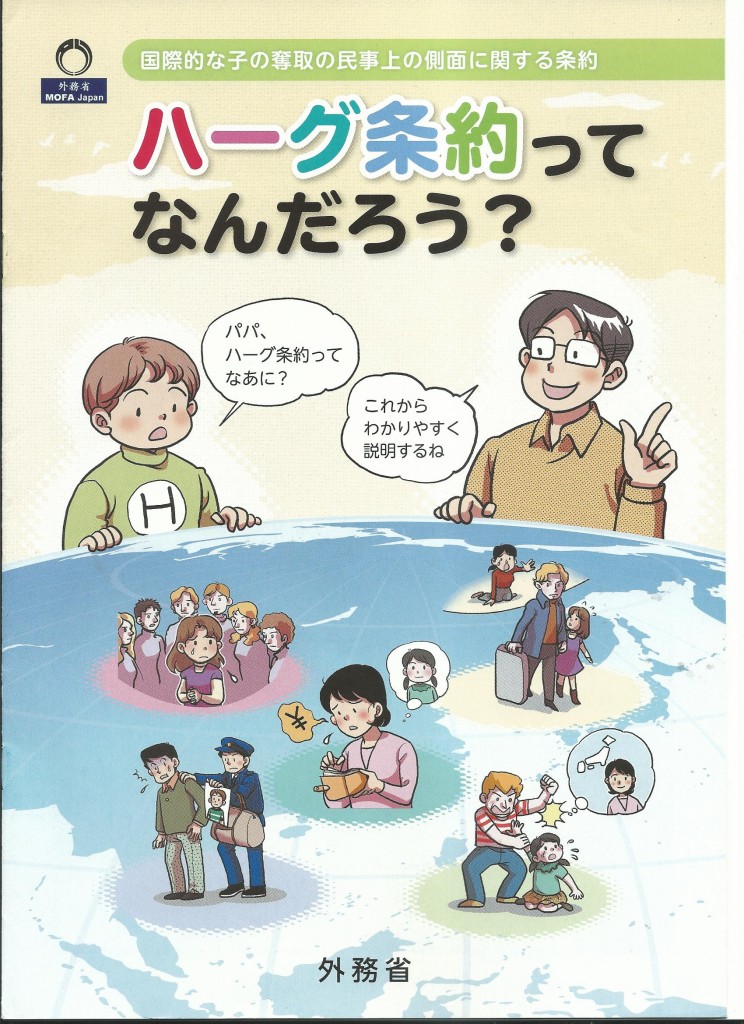
This is the cover image, with a father about to explain the Hague to his curious son, and look what makes the first impressions: The J mother sobbing as the NJ parent whisks their child from her grasp. The child being stared at and not fitting in with her big-nosed NJ classmates (Japanese rarely have much of a nose in Japan’s international illustrations; it’s a style, but it makes it seem as if NJ are never Asian; never mind). The J father being nabbed by the police regarding his kid. The J mother short of money when thinking of her daughter. And, of course, the obligatory drawing of the physically-abusive NJ parent with the child longing for her J mother. The point is, the J mother is in most situations the one being victimized.
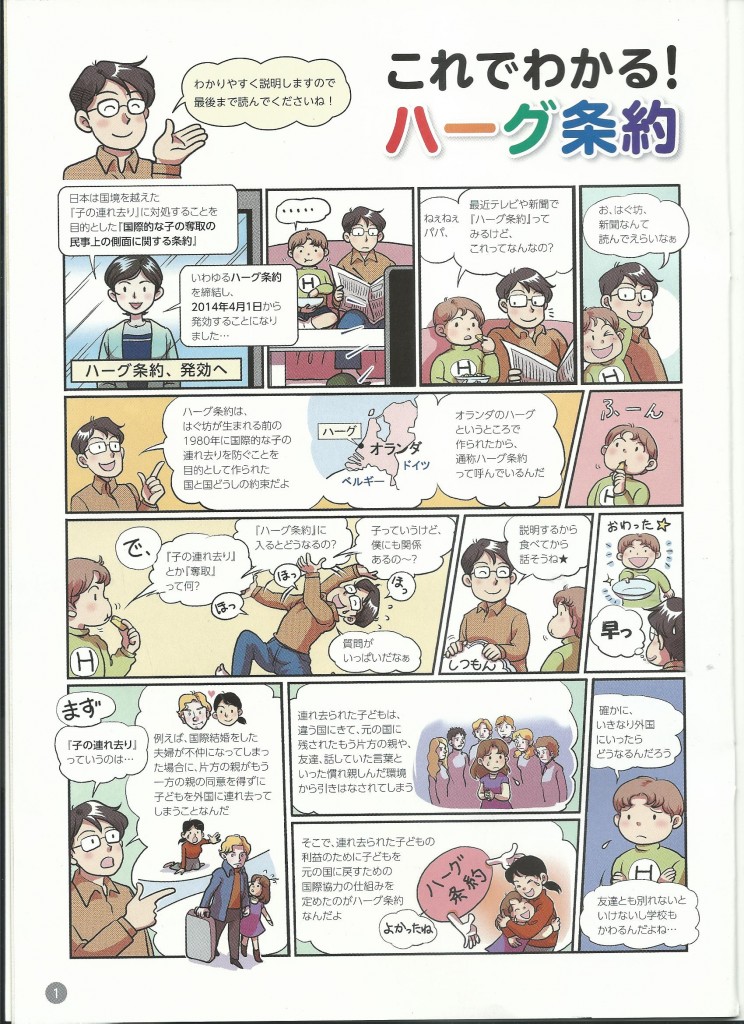
The first page already has a case of the cutes (even though, since this book has no furigana over the kanji, it’s a manual directed towards adults, not children), with a J father explaining to his son suddenly overwhelming him with questions (after complimenting him on his interest in the news) about how, as of April 1 2014, Japan has to follow the Hague regarding the “tsuresari” (“accompanying and disappearing”, not the more hot-button term “rachi” used for “abductions” when it’s Japanese being abducted to North Korea) of children. After making a deal with him to eat all his dinner before hearing more, we have a prototypical J=NJ union couched as between a Japanese and a Gaijin (even though most international marriages in Japan are overwhelmingly between Japanese and Asians): the NJ male makes off with the child, the child has trouble fitting in overseas due to language and environmental difficulties, and the child is happily returned to the J mother’s arms thanks to the glad hands of the Hague Treaty thinking of the best interests of the child. By the end of the page, the son is already shuddering to think what it might be like to live in a foreign country, what with no friends in school and all that.
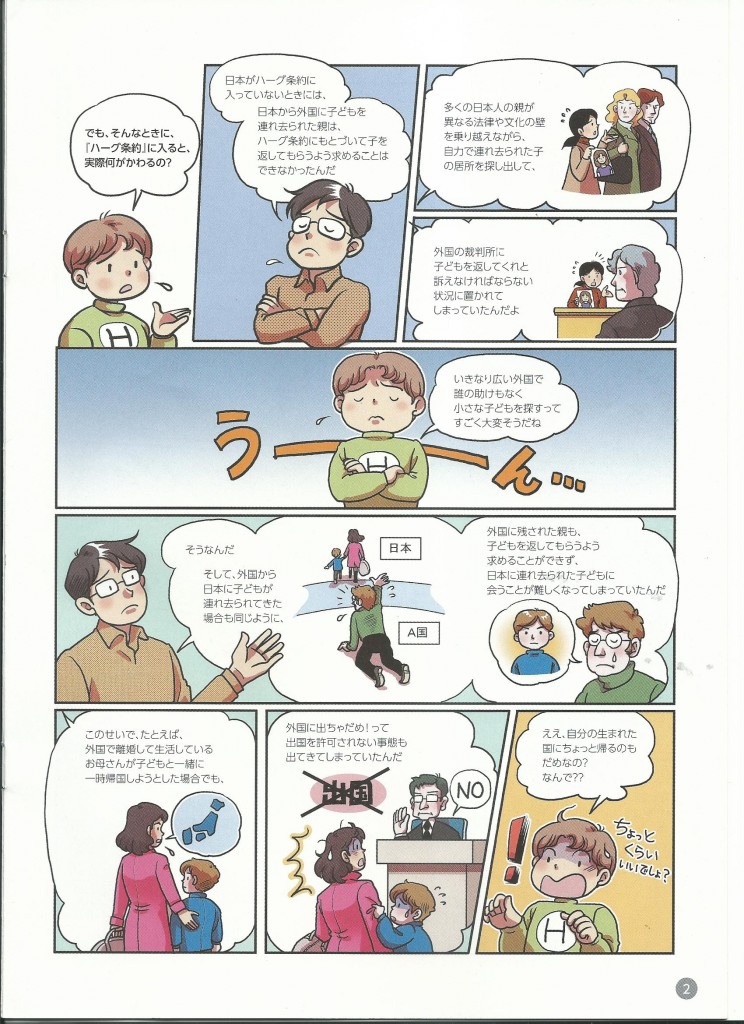
Next page has more explanation about what will change under the Hague. The first point is that Japan had no standing to have children returned if they were abducted. The poor victimized J-mother had to find her child with no help (apparently by showing a photo to taller Gaijin strangers giving her the cold shoulder), and even had to go to court to ask for custody (in a place with different laws and culture!). How terrible, the child notes, for the parent to suddenly have to go to a big country and look for a little child. Of course, then the converse is depicted to be true (but without the sobbing child pining for his NJ dad as the J mom takes her back to Japan — in fact, more alarm from the child that he can’t return to Japan), with consequent difficulties in seeing their child (NB: Nowhere mentioned is the fact that joint custody and visitation is guaranteed in some of these overseas places with the dreaded “different laws and cultures”, but not in Japan.) And what about the case where the divorce takes place overseas and the J-mother wants to take the child back to Japan? The courts will deny the mother the ability to leave! (“What, you can’t go home to your country of birth??” proclaims the ever more-startled son at the end. Even though that exit denial didn’t happen, for example, in the Christopher Savoie Case, which is why the abduction of his children occurred.) Conclusion: Already the issue is portrayed in a lopsided manner, with the J-mother being the more victimized party overseas.
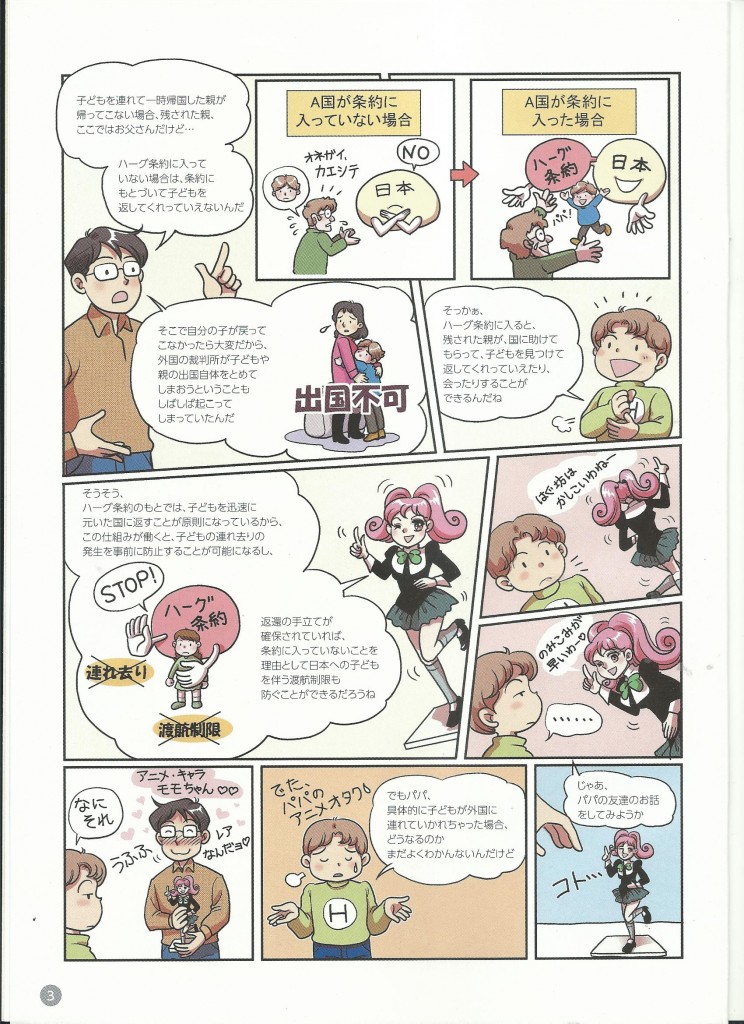
Next page succumbs to an even more silly case of the cutes, not only with the katakana-accented NJ begging a J court for his child back, but also with an animated doll appearing as an interlocutor because Papa happens to be an anime otaku fetishist (rather unbecoming of a serious issue in a serious pamphlet issued by a national government). Carrying on… This section talks about how signing the treaty makes it so that either side can have their child returned, meaning this will stop courts from hindering parents from returning to their countries at will, because if problems arise, there is an apparatus where courts can return the child if necessary. (NB: Not mentioned is that there has not been a single recorded case in Japanese court where a Japanese child has been returned to a NJ parent’s habitual residence overseas, meaning there is no precedent that the apparatus will work on the Japanese side.) It also will probably act as a means to preempt abductions, says the pamphlet.
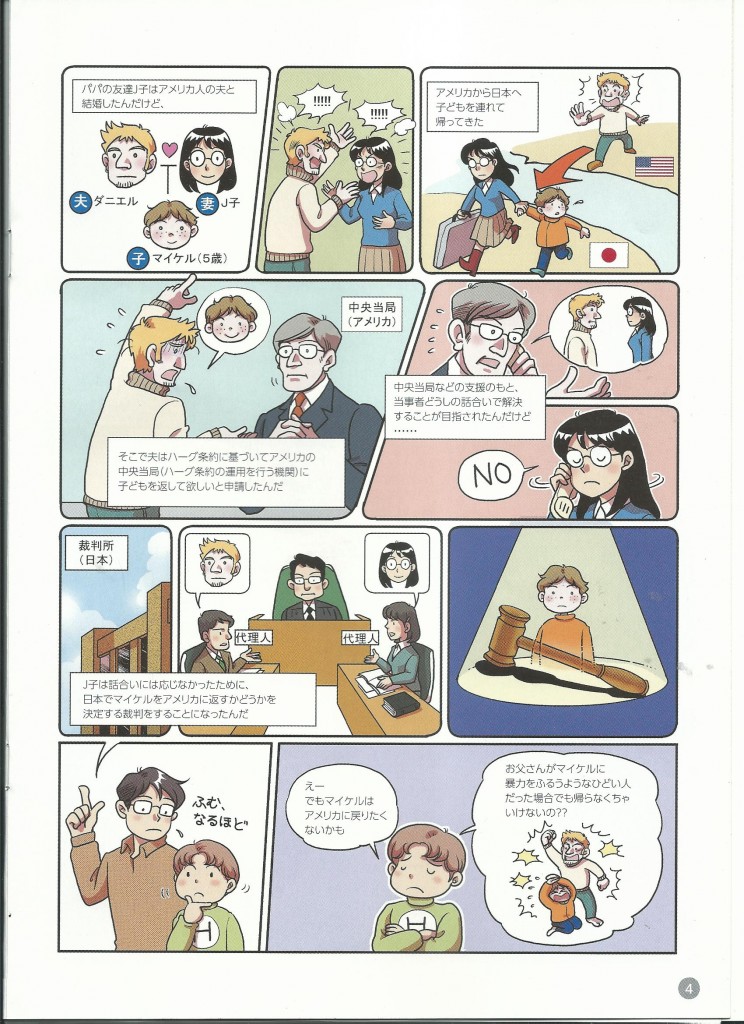
Then the pamphlet turns to a case of one of Papa’s friends (a J mother married to a NJ father) who abducted their child to Japan. It went before a Japanese court, with the child standing at the mercy of the gavel, fate uncertain. But just to make sure there is a lingering scare, the son expresses doubt as to the justice of a child being repatriated to a physically-abusive (!!) NJ father (where did THAT presumption come from?). Once again, the NJ father is being portrayed as potentially abusive, even though, naturally, abusive J (mothers or fathers) exist in Japan.
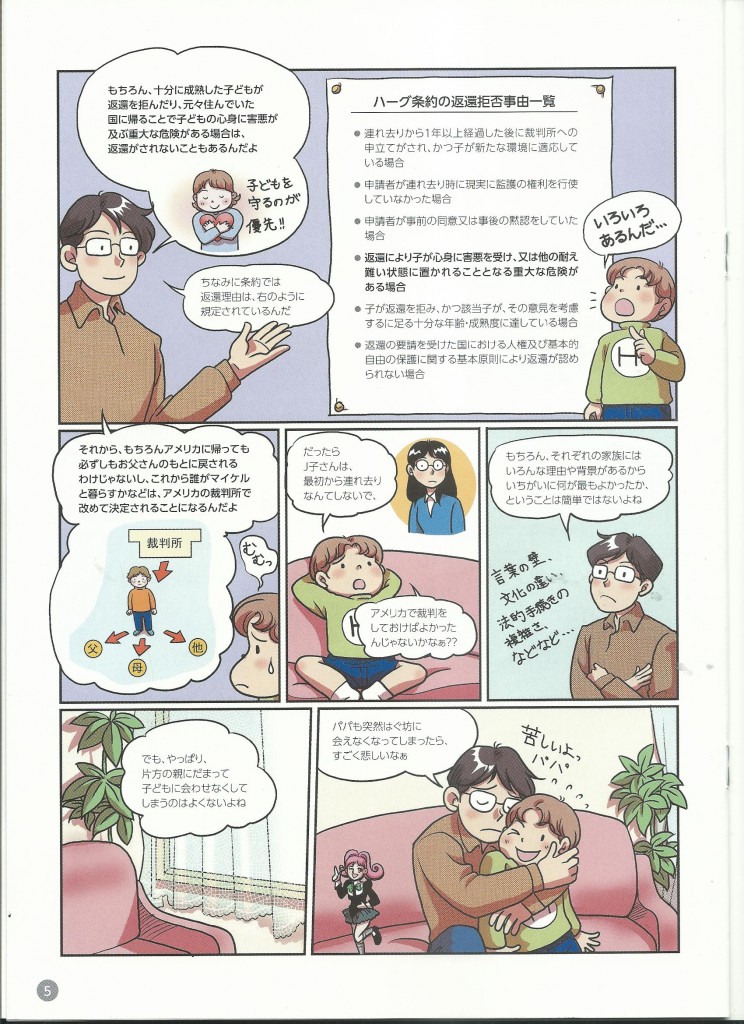
Next page allays the fears of injustice, with a list of reasons why a child would not be forcibly returned thanks to the Hague (bonus image of the loving mother embracing a heart and saying that she will prioritize the protection of the child). But — horrors — at the suggestion by the child that Papa’s friend shouldn’t have abducted the child and should have perhaps gone to court in America, Papa immediately kiboshes that by mentioning how American courts have a different culture, procedures, language barriers, and might even award custody of the child to a third party! (Again, no mention of the possibility of joint custody or guaranteed visitation rights enforced overseas, neither of which are permitted in Japan due to the koseki Family Registry system, aka “different culture”). The nuance of this section becomes “it’s oh so complicated, no wonder Papa’s friend abducted their child”. Conclusion of this page: It would be awful if one parent couldn’t see their child (which is disingenuous coming from the GOJ because, as mentioned above in the introduction, child abductions without joint custody or visitation rights even between Japanese parents in Japan are quite normal).
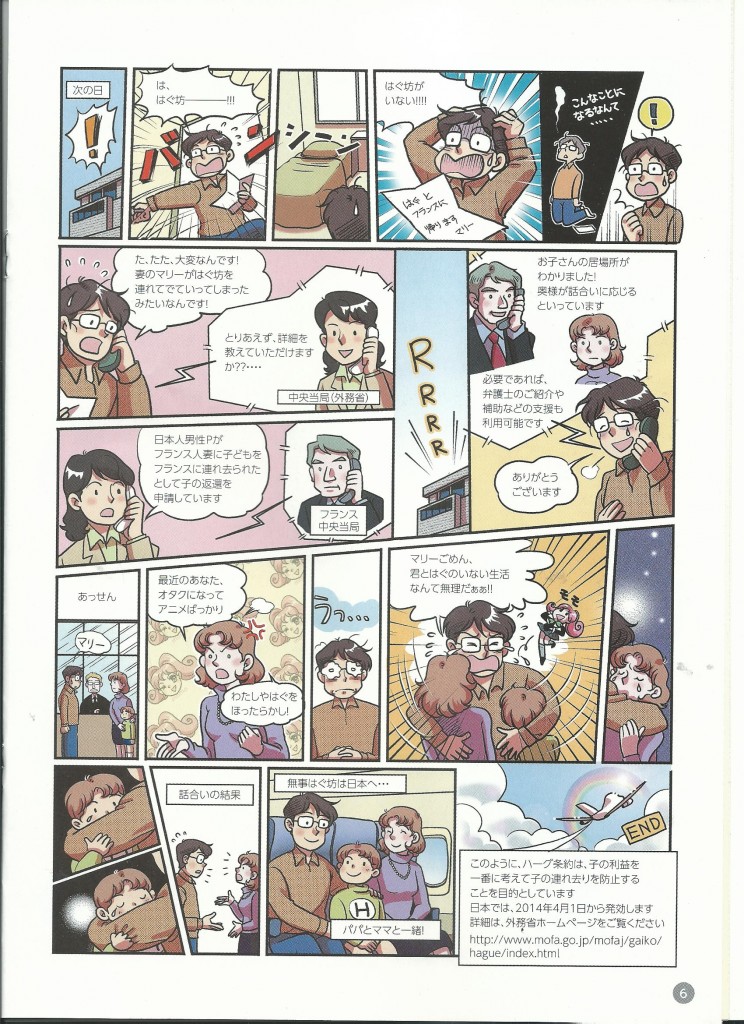
Suddenly, a sad fate befalls even this family, what with Papa being revealed as married to a French woman named Marie (who speaks normal Japanese; DV and broken Japanese seem to be the lot of the Western NJ male) who has run off to France with their boy. Fortunately, thanks to the Hague, the GOJ can intervene, contact the French government, ascertain where she and their child is, get the authorities over there to mediate, get Papa to abandon his anime fetish (good thing he’s not a physically-abusive man; it’s just a harmless fetish, so nothing to fault the J man overmuch for as any serious grounds for divorce, right?), and get them all to make up and fly into the sunset back to Japan for a happy life ever after.
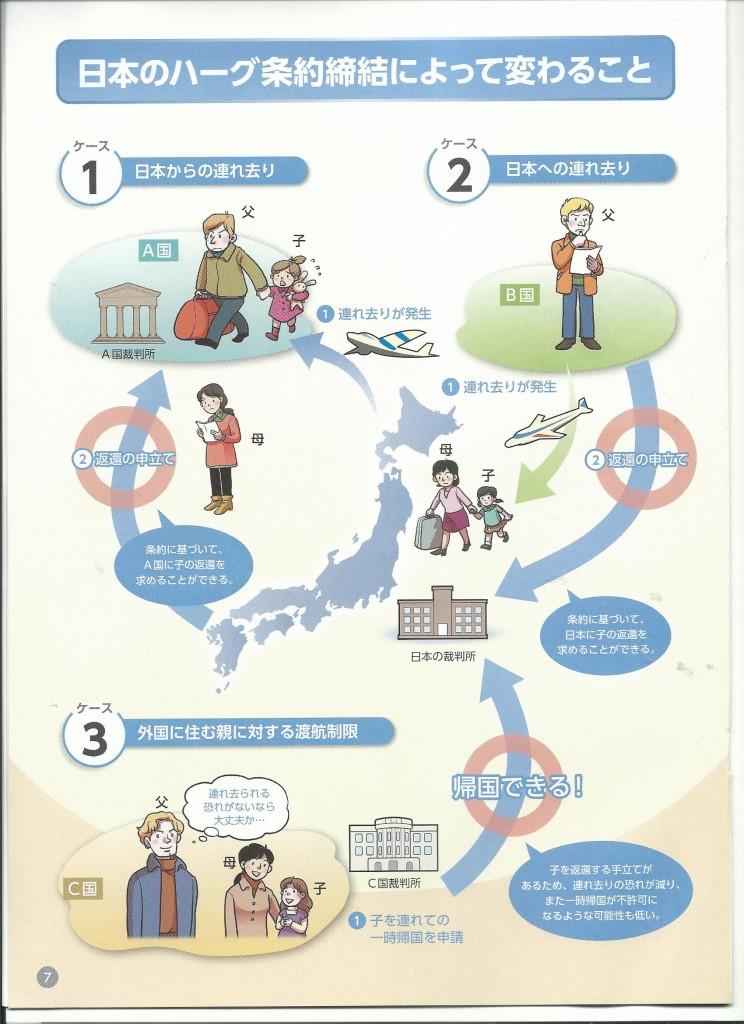
Next page outlines the Hague procedures in three basic steps. Of course, it’s all NJ men and J women (three different couples). Visually, note the nuance of the child once again being more distressed to be leaving Japan with her father than going back to Japan with her mother.
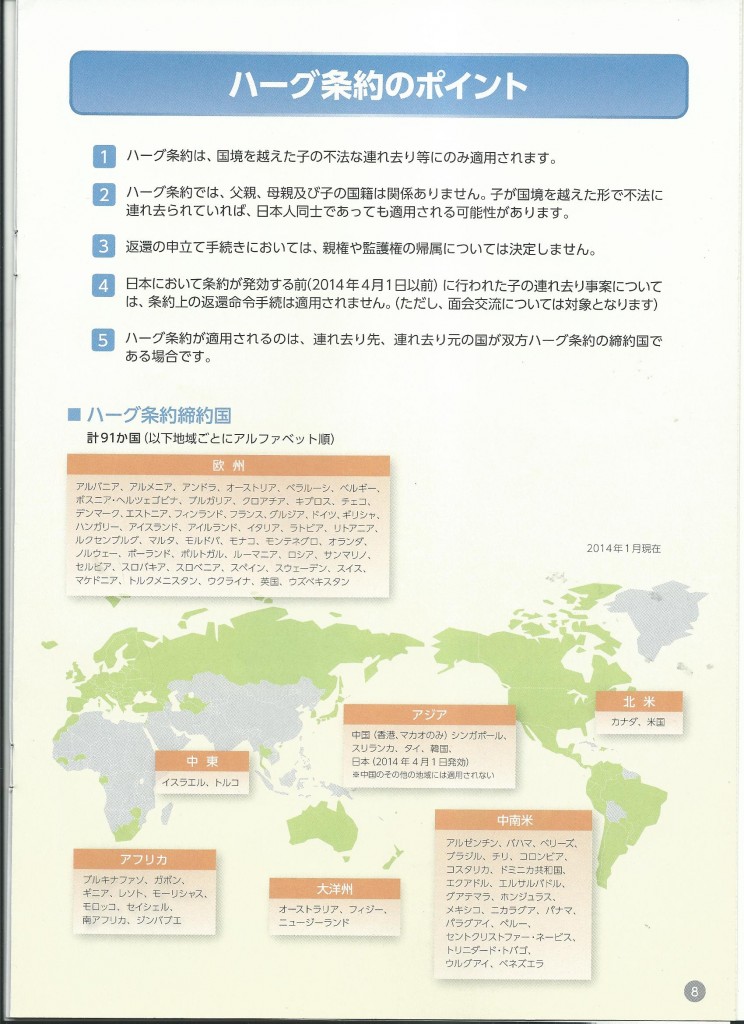
Next page lists the countries that are signatories to the Hague and the key points of it in bullet form.
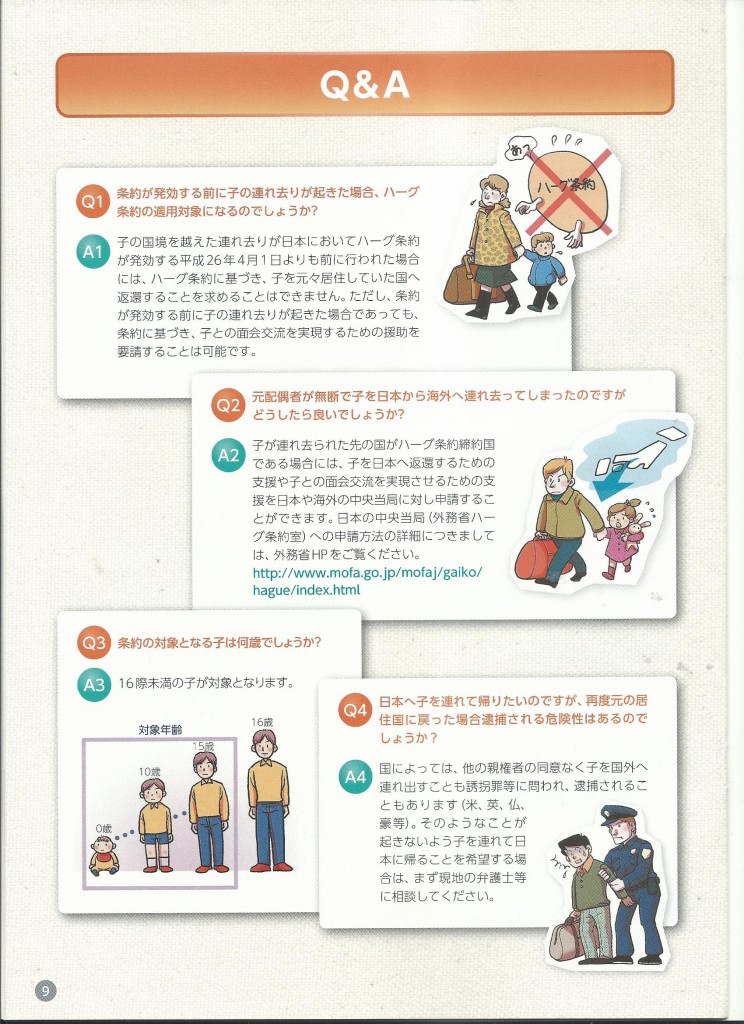
Next page gives the key points in Q&A format, first with what happened before Japan thankfully signed the Hague (abductions with impunity!), second with what to do if an abduction from Japan to a signatory country takes place, third with how long the Hague is in effect (until the child is aged 16), and fourth with a warning not to go abroad and reabduct your child back (you’ll be arrested; get a lawyer).
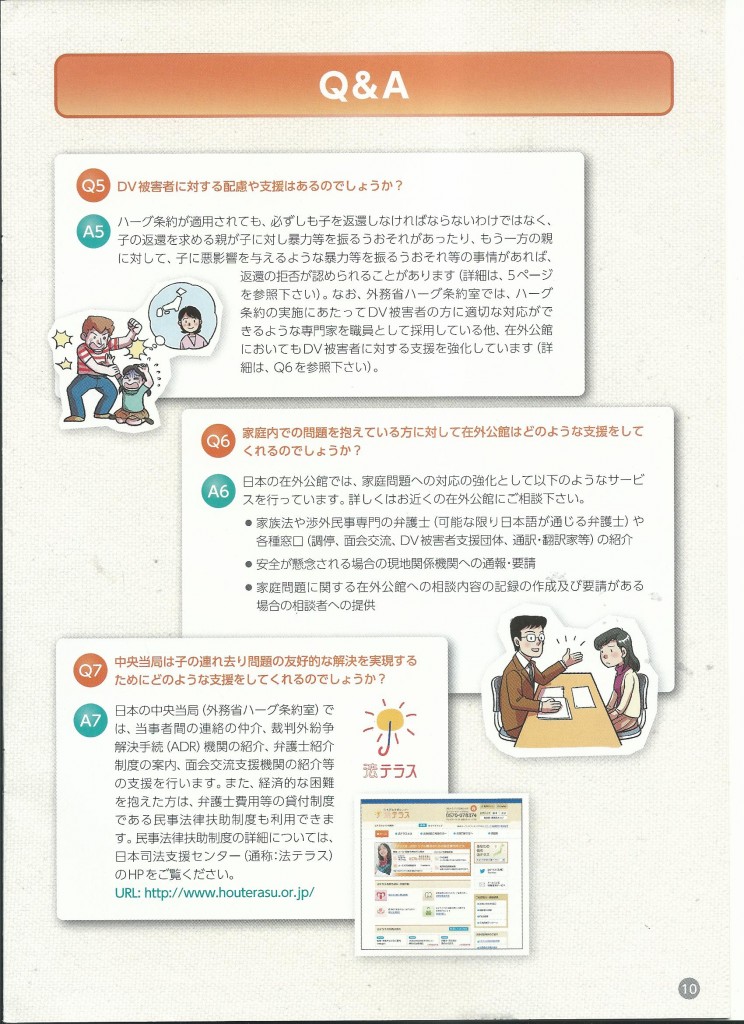
The penultimate page gives more Q&A, with the obligatory 5) what to do in cases of DV (paste in NJ dad child abuse image again), or even the possibility of DV in the past (ko ni aku’eikyou o ataeru you na bouryoku), with a special section on page 5 above just in case you should want to use Japan’s increasingly grey and loose definitions of DV to get your child back; 6) getting J diplomats to help you out overseas; 7) getting a better understanding of the laws and Alternative Dispute Resolution using public resources.
The pamphlet ends with the boy saying how he understands it all now, and the dad saying how nice it would be if more countries signed the Hague. Quite. But not the way it’s being interpreted here.
ENDS
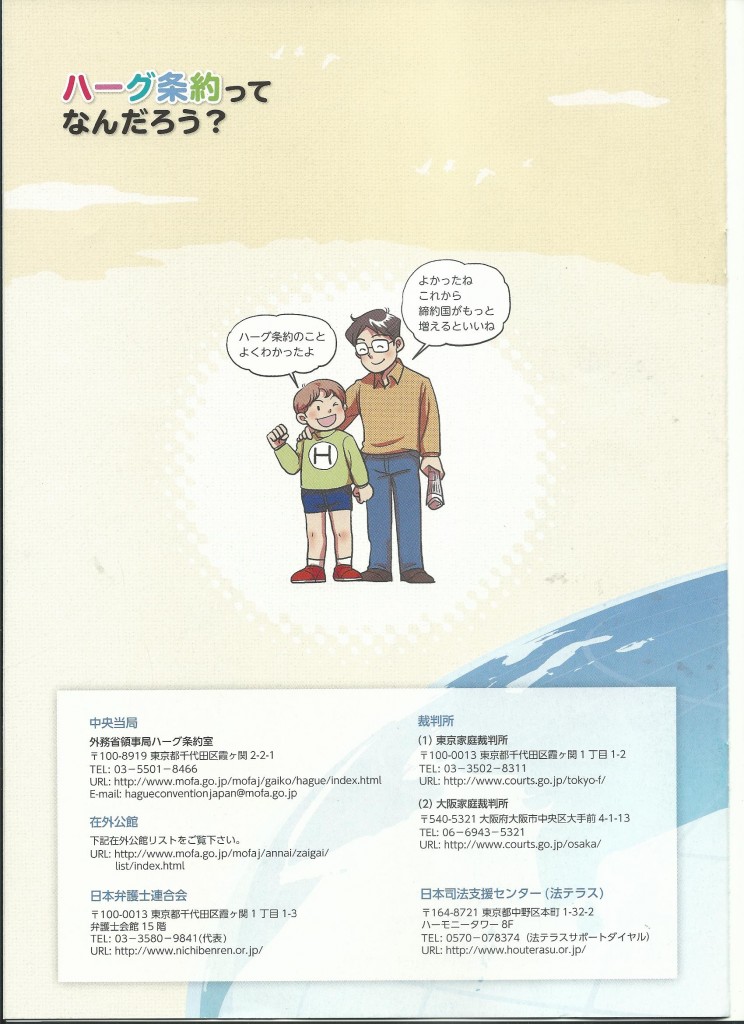
39 comments on “2014 MOFA pamphlet explaining Hague Treaty on Child Abductions to J citizens (full text with synopsis, including child-beating NJ father on cover & victimized J mothers throughout) UPDATE: With link to MOFA pdf and official E translation”
Thanks. That was lovely. It is telling that they thought it prudent to have three couples, and yet all three couples are NJ men with J women. I guess the (diminished capacity) drones at the MOFA think this is what passes for a fair and balanced explanation of the Hague Convention on Child Abductions.
Debito – will this have any impact on the hundreds of children abducted to Japan in the last few years? Can foreign parents use this to get visitation rights?
— Dunno yet. Some Hague access cases are already in progress…
Loooove how they call the NJ’s home country A国。Geee, that doesn’t rhyme with anything at all, does it?
Ironically, I grew up in Southern California, where having an Asian kid in class is about as uncommon as Kenny dying in South Park. But that would contradict this manual’s point! Ugh… I’ve seen episodes of Star Trek Voyager that weren’t as sloppily written…
Ha! Racism pure and simple.
Wow. Just. Wow.
This is truly disgusting. I’ve lately wondered if, maybe, my disgust with J-racism is, you know, overtaking my life. Taking over my happiness, positivity, whatever. I try to talk to my students about issues, and the international issues that involve Japan are overwhelmingly negative on the Japan side.
But, no. The government made this? This is literally propaganda. Seriously. This is not an “informative pamphlet.” Let’s call this what it is: racist propaganda. As Debito pointed out, the “pamphlet” purposefully ignores the fact that many (most?) of the cases involving abductions in Japan were with abusive Japanese MOTHERS, not foreign fathers. (And yes, telling your child that her father doesn’t love her and will never come for her is insane psychological abuse. I have a student whose mother has literally done this to her, and I have no idea what to say or do to her.)
The thing is, this isn’t just a man making a reckless tweet, like the recent Kaneko incident. Or a man saying something stupid in a press conference, like the recent gaffes from NHK leaders.
This must have took months to research, script and draw up. How many people are involved in a full-color comic? At least two to three – the penciler, the inker and the colorist, right? This is an entire team of people who purposefully made a full-color comic book of lies, prejudice (seriously, katakana?) and reverse stereotypes. No, Japan, it isn’t white dudes who have little anime doll fetishes. That would be Japanese guys. No, Japan, it isn’t white dudes beating and kidnapping Japanese children. It’s the Japanese mothers. It’s not the foreign governments that have bizarre and unfair laws, it is seriously Japan that is the problem here.
Wow. Wow. Wow. Wow. Wow. Wow.
The repetition of the blonde guy with a big nose and unkempt hair with a frown on his face, or in the midst of an open-mouthed scream, who is abusing somebody/thing really freak me out as I begin to wonder if that’s how many of the folks who work in government really interpret my presence here — a flat-character in the background who is always about to do only one thing, like a catch-phrase in a sitcom with a weird neighbour, except instead of comedy, it’s violence.
Full Document available:
http://www.crnjapan.net/mofadoc.pdf
Dude, In terms of children that were previously abducted to Japan, or in cases of denial of visitation YES article 21 of the Hague says parents and children should have access. That said, Japan has already removed parts of the Hague it didnt like prior to signing it. If you or anyone you know has a case of abduction they should file a Hague case for access and visitation, ASAP.
So Japan is pressured to accept the Hague Convention because it is a haven for international child abductions, then makes a pamphlet to explain to it’s own people implying that it is to protect them from other nations. Am I understanding it right?
Can’t you send this to some international authority concerned with the Hague treaty on child abduction, including your translations?
This is totally underhand and goes against the spirit of voluntarily signing a treaty.
It totally undermines the obvious benefits for all concerned parties of Japan implementing the convention and is blatantly anti ‘the other’, and, as you said, is ‘misinformative’ about certain facts (most countries who signed, accept the legal principle of joint custody) that it borders on lies.
Gaimushou should not be allowed to get away with this one.
— We have some people sending it to their US congressperson.
This is digusting. Pictures are powerful, more powerful than words. And the only time I’ve ever seen anything remotely like this is when I did a search for old anti-Japanese propaganda. Of course, that was disgusting too, but it was war time!
https://www.google.com/search?q=american+wartime+anti-japanese+propaganda&hl=en-GB&rlz=1T4GUEA_enJP472JP472&tbm=isch&tbo=u&source=univ&sa=X&ei=VcwWVLSkMcfn8AX2qICYCg&ved=0CDIQ7Ak&biw=1280&bih=594
Crying children being dragged away from their wailing mothers, or children and mothers being physically abused by big-nosed white males. Can you see it for the propaganda that it really is? I doubt very much that the Japanese can.
Shocking and disgusting. Thanks for bringing it to my attention.
I have sent it to my representatives. No matter what happens on a daily basis in businesses or from ordinary people, the issues that really light me up are how officialdom portray and treat non-Japnaese.
I have contacted my representatives with a summary and the link to this site. Congress brought the pressure – the worst thing they can do is stamp the issue as “fixed” and forget about it.
Ugh…just more of the same old pathetic immature cartoon “we can control their faces and expression” nonsense.
What a pathetic advert for an “advanced” country. As for the text….. Not wasting any more band width on such utter racist xenophobic patronsing paranoid nonsense.
Frankly The Beano was a better read, at least we knew it was a fantasy and a comic!
Hi Debito
Can I send you some photoshopped images of this, that I did myself? If so, how do I send it. Thanks.
— Sure. Try debito@debito.org.
I personally don’t think MOFA officials made this silly leaflet. It’s just too dumb and misleading. I’m suspecting they might have used their contacts to get private vendors for this publication under their name and logo.
— It’s still MOFA’s, under their logo, as you say. They are completely responsible for its contents and the image it projects of their organization, as Japan’s official representative to the outside world.
I am very offended by this. I feel like my rights/privacy have been trampled upon. My name is Daniel. I have blonde hair and blue eyes. I’m American. (so obviously I am a stereotypical abusive foreign father. Specifically to me, this is alarming. I will be writing some letters.
Biased propaganda of course, but to a domestic (Japanese) audience- I think they are trying to “sell” the Hague and dumb it down to to the J public along the lines of “what is in it for you”-which is of course a win for Japan and a lose for NJs-rather than a more impartial “appeal to fairness and universal rules” or win-win, which doesnt go down in Japan and other nationalistic parts of Asia, (even Hong Kong in some cases, below CEO level).
Its all about what Japan can get out of it, self interest, independent advantage, which they will no doubt ensure in practice with their re interpretation of “the rules” and how to implement it. Never mind whats fair.
“Papa happens to be an anime otaku fetishist (rather unbecoming of a serious issue in a serious pamphlet issued by a national government).”- love this bit, and I think its par the course a la Taro Aso, J-soft “power” (haha) and the serious lack of adult alternatives as means to attract NJs to Japan- although it turns out papa is in fact a Japanese Otaku.
Dont underestimate the ability of the Japanese authorities to sell neo fascist messages using cutesy images- Emperor Hirohito was of course, a big Disney fan and he requested to be buried with his Mickey Mouse watch, his most cherished possession apparently.
This is not related directly to the pamphlet in question. I’d just like to recommend Douglas Galbraith’s book My Son, My Son which is his account of his battle to restore contact with his child from his marriage to a Japanese woman. The child was abducted from their home in Scotland and brought back to Japan. It gives a good picture of how frustrating and harrowing this situation is. It’s easily available on kindle. (I’ve no connection with the author, by the way.)
Anti China bashing also-check out the map which points out under the Asia section that “China etc isnt covered by the Hague”- no other country that is not included gets a mention worldwide.
Nationalistic subtext- hey, J dudes, stop marrying those Chinese girls.
Also, love the ending where J papa wins through determination rather than conceding anything-Japanese anime is pedaled as a positive thing even if the NJs dont get it-again, par the course of Japanese thinking that through “gaman” and nagging persistence rather through concessions, the other party will eventually weaken and cave in.
An Asian female friend of mine did divorce her J husband for being a game freak (“he preferred to play computer games rather than play with me”), so perhaps this is becoming a serious issue for the large demographic (20%) of Akiba anime/game males upon marriage?
Those rare figurines can cost a lot so papa’s obsession might well eat into the family budget.
Regarding the anti China vibe here- although not a Hague signatory, apparently China does uphold joint custody, unlike Japan which appears to be one of the last holdouts on this issue:
“One of Japan’s favorite myths, proffered to justify parental kidnapping, is that joint custody is strictly an undesirable “Western value,” and therefore Japan should not have to capitulate by adopting such a peculiar foreign practice. However, since Japan’s Asian neighbors — Taiwan, South Korea and China — as well as other non-Western countries, such as Nigeria and countless others, recognize joint custody and also routinely enforce U.S. and other valid custody orders for joint-parenting time, this “Western value” assertion falls flat on its face.”
Quote from Japan Times article by Amy Savoie.
This should have been in the cover cartoon instead. One of MOFA’s very own elite… sent to prestigious Silicon Valley Duty post by the Authors of this pamphlet, MOFA no less… wonder if he would have been given a 1 year jail sentence in Japan??? All the commotion about Ray Rice and yet, this one flew under the radar…
http://sanfrancisco.cbslocal.com/2013/03/18/japanese-diplomat-living-in-san-bruno-sentenced-for-domestic-abuse/
Enough said?
Wow, nothing changes.
Another demonstration of switching reality on its head.
1. Japan has a major public relations issue with the fact that its nationals are kidnapping children and then expelling the “foreigners” from access to children.
2. International pressure mounts on Japan for it to sign an international convention that tries to tackle the issue of child kidnapping.
3. Japan signs international convention but plainly does it because of gaiatsu and international pressure and bullying; Japan and Japanese as victims.
4. Key message 1: If you are silly enough to marry gaijin, then beware, because all of these extra problems are waiting for you when rescuing your child from the gaijin bullies
5. Gaijin are gaijin or gaijin: the bottom line is it’s us and them and it’s a power game. Your husband or wife isn’t a husband or wife. When push comes to shove, (s)he is a gaijin and fundamentally different. Don’t expect him or her to understand you or Japanese society. Remember though, your child is a Japanese because of his or her “blood.”
#14 Loverilakkuma: The pamphlet can be found on the MOFA website, so it is genuine. PDF is here:
http://www.mofa.go.jp/mofaj/files/000033409.pdf
(link from this page: http://www.mofa.go.jp/mofaj/gaiko/hague/index.html)
And there is even an English language version!
http://www.mofa.go.jp/files/000034153.pdf
(link from this page: http://www.mofa.go.jp/fp/hr_ha/page22e_000249.html)
— Thanks Oliver!
Just to clarify: Did Japan sign the entire Hague treaty, the parts they like, or an edited version (“Hague Light”)? If they signed on to parts, which parts?
@ FaithnoMore #21
Lots of interesting points.
What should be a easy to understand document that explains clearly, simply, and professionally to Japanese people what joining the Hague Convention means, has instead become an exercise in brainwashing anti-NJ propaganda.
There is no particular reason that I believe that this pamphlet should inform the reader that ‘Japan has a history of being a safe haven for child abductions’- it’s not something most readers would need to know, clouds the issue (which is explaining clearly what joining the Hague Convention means), and will just alert Japanese sense of victimhood.
However, looking at the pamphlet, which presents a totally inverted fictional account of child-abduction realities in Japan, it is clear to see that MOFA are well aware of the reality of the issue, MOFA have already gone into ‘victim Japan oppressed by gaijin who don’t understand our unique culture’ mode, and have inverted the issue in order to deflect from Japan’s short-comings, and present a ‘but you do it too’ narrative.
It fits the pattern;
1. Denial of the problem.
2. Deflection.
3. Moral equivalency.
We’ve seen this on the wartime sex-slave issue, Nanking massacre, Fukushima, whaling, you name it. Victimhood IS Japan’s ‘unique culture’.
Who can we contact at MOFA to let them know how awful this thing is?
@Oliver, @#22
I know the pamphlet surely belongs to MOFA. I was just wondering which department within their organization came up with that racist/sexist PR. Seems like they have some computer graphic/animation crew (either hired as regular ministry personnel or outsourced from private company)work under the supervision of senior editors in the public relation.
And here’s their video clip on the Hague Convention. This one may not be as offensive as the brochure, but they conveniently ignore the fact that it is Japan’s historic indifference to the incidents caused by their own citizens that created the situation.
http://nettv.gov-online.go.jp/eng/prg/prg3801.html
@Dude, #23
They surely did. As a formality. But nothing more than that.
As their gross pamphlet decribes, the MOFA clearly puts their interest in (ethnically) Japanese nationals over non-Japanese, even though the latter is recognized as victim of partner’s abuse or alienation. Their narrative is clearly based on the hypothesis that NJ fathers/spouses take the kids and leave Japan for their home country–rather than Japanese parents taking the kids away from foreign partners to go back to Japan for good.
I wouldn’t be surprised that they would keep protecting Japanese individuals who left foreign country with their kids without consent to their partners or ignoring the court order of local country. It’s highly questionable if the Hague will kick in when aduction occurrs in Japan, but abducting parents are Japanese who reside in Japan by deliberately alienating the kids from their partners.
There seems to be an office (室)within MOFA called ハーグ条約室 run by a man/woman called 孫崎 馨 Kaoru Magosaki. This should make his/her e-mail address kaoru.magosaki(at)mofa.go.jp.
I would assume he/she would know more about the actual pamphlet.
This Huffington Post article (Japanese) mentions Debito’s coverage of this manga.
The journalist who wrote this claims to have contacted MOFA and was told no complaints had been made with respect to the discriminatory nature of the publication.
http://www.huffingtonpost.jp/2014/09/17/pamphlet-of-the-hague-convention-mof_n_5833674.html
投稿日: 2014年09月17日 16時34分 JST 更新: 2014年09月19日 14時17分 JST PAMPHLET WHAT IS THE HAGUE CONVENTION
国外に連れ出された子供の扱いを定めた「ハーグ条約」について、外務省が作成した小冊子に人権侵害にあたる内容が含まれているのではないか、という指摘が出ている。
指摘しているのは、人権活動家の有道出人(あるどう・でびと)さん。アメリカ出身の日本国籍取得者だ。有道さんは「ハーグ条約ってなんだろう?」という外務省が作成した小冊子について、子供や無実の日本女性に暴力をふるう外国人のイラストは、嫌悪感を抱かせる内容となっていると分析。日本人のかつての配偶者によって子供を連れ去られ、子供に会うことができないでいる外国人もいるとして、小冊子のあり方に疑問を呈しているという。香港の英字紙・サウス・チャイナ・モーニング・ポストが報じた。
有道さんは特に、小冊子の表紙のイラストに怒りを覚えるという。そこには、小さな女の子を叩いている外国人のイラストや、ブロンドヘアの外国人男性がすすり泣く日本人女性の母親から子供を連れ去るイラストなどが描かれている。有道さんは「このような内容は、日本だけが公正な話し合いができる場所で、世界は違うというようなイメージを植え付ける」と話す。(中略)
「これらの固定観念のイラストばかりでなく、なぜ、元妻に連れ去られた子供と会うための外国人の権利について書かないのか」と有道さんは指摘した。
(サウスチャイナ·モーニング·ポスト「’Racist’ cartoon issued by Japanese ministry angers rights activists」より 2014/09/16 23:14)
pamphlet what is the hague convention
ハーグ条約は夫婦のどちらかによって国外に連れ出された子供の扱いを定める多国間条約で、日本は2014年4月から条約加盟国となり、合わせて小冊子もつくられた。
日本はハーグ条約への加盟が遅く、海外から批判を浴びていた。特にアメリカからの圧力は強く、2010年にはアメリカ下院本会議が日本への連れ去りを「拉致」と非難する決議を採択した。ハーグ条約の適用を受けた2014年4月には、元配偶者らが日本に連れ帰った子供との面会を求める親が、アメリカでは少なくとも約200人に上ったという。
有道さんは自身のブログで、この小冊子の中に、外国人が子供にDVを行っているイラストが複数あることや、外国人が日本人に冷たいことを明示するイラストも使用されていると述べている。
pamphlet what is the hague convention
pamphlet what is the hague convention
pamphlet what is the hague convention
これらの有道さんの指摘について外務省領事局の担当者は、現在のところ外務省は同様の指摘を受けてはないとハフポスト日本版の電話取材に回答。また、「小冊子を見ていただければ分かると思うが、人種差別的な内容を意図して作成したものではない」として、画像の変更等を行う予定はないと述べた。
なお、この小冊子は日本語版だけでなく英語版もつくられているが、日本語版と同様のイラストや文章が使われている。
ENDS
This will be just another hallow agreement. With virtually no enforcement/support. That is what the pamphlet is implying.
Interestingly, the English language version on MOFA website has a really professional, non-patronizing, non-racist explanation of the whole thing. I guess they know that this is the version that the foreign media (at least, that’s what they hoped), and the UN would be looking at;
http://www.mofa.go.jp/fp/hr_ha/page22e_000249.html
Umm, one version in Japanese for Japanese people, and another version, with a completely different explanation in English, for ‘the rest of the world’. Where have I seem that before?….OH! The Fukushima report! This government’s established a pattern of being two-faced.
Well, in what seems a tangent to all of this, it is very much business a usual and ignoring the rest of the world for its own interests, yet trying to say it is now “part of the club”…
On 31st March the ICJ stated:
“..The UN’s International Court of Justice (ICJ) has ruled that the Japanese government must halt its whaling programme in the Antarctic..” and went on “…Nori Shikata, political minister at Japan’s UK embassy, said Tokyo would abide by the ICJ decision..” *
So Japan wants to play with the big boys and be seen as compliant to the big boys club. We are civilised and a nation of Laws..
Yet….oh dear:-
“…The Japanese government has vowed to restart its controversial whaling programme in the Antarctic next year….Japan maintains its annual hunt is solely for research….” **
So, that is a resounding NO then to abiding by the rule of Law and being part of the big boys club, simply because it does not align with its version of the world order and being told what it can or cannot do.
Thus, as with the Hague Agreement, lets see a show of hands for those that think Japan will abide by the big boys club ruling dictated by the UN on human trafficking and child abductions??
Hmmm…can’t see any, funny that!
Oh, so sorry we are peace loving and respectful country and abide by the international rules of Law…yeah right!
* http://www.bbc.com/news/world-asia-26818863
** http://www.bbc.com/news/world-asia-29268826
32 John K. – Thank you for bringing this to my attention.
This is a very common Japanese tactic – to agree, for the sake of ‘harmony’ only to later do as they want.
Regarding the Hague, I think Japan is bowing to foreign pressure by signing it. They will default to racial stereotypes regarding enforcement.
Regarding the mindset that made the Japanese version of “Hague は何?” – I think many observers are overlooking Japan’s group responsibility dynamic. Let me explain:
Through my years living in Japan, I slowly discovered a disconnect from reality among average Japanese people:
I asked a coworker who those Japanese guys were hiring out foreign prostitutes in Okubo. The answer:
“Those are Koreans. Japanese people do not do things like that.”
Interesting, I thought, that my coworker would so readily know the nationality of people w/o meeting them.
So I asked others the same question, and discovered that virtually all Japanese people (old and young) knew this ‘fact’.
Surely this would not apply to other areas…
How about the guys in the black trucks? Who are they?
“Those are Koreans. Japanese people do not do things like that.”
Wow. I see a pattern!
Yakuza?
“Those are Koreans. Japanese people do not do things like that.”
This was too much for me. I could not believe that Japanese people were so perfect. Surely I could find something bad done by a Japanese person?
How about WW2 atrocities? Many POW’s were mistreated by Imperial Japanese forces, tortured, starved, and murdered. Who did that?
“Those were Koreans. Japanese people do not do things like that.”
Amazing!
My point: In 7 years in Japan, and the many years since, I have never found Japanese people willing to admit any wrongdoing by Japanese – ever.
This cannot be a coincidence.
My theory:
Since the success of one Japanese person is the success of all Japanese people, it stands to reason that a bad deed done by a Japanese person will bring shame to all Japanese people.
Therefore, bad deeds done by actual, real “100%” Japanese people cause a real problem – how to reconcile bad acts with the above concept.
Actual Solutions:
1) As much as possible, blame non-Japanese.
2) If Japanese, blame non-Japanese bad influences. (remember the Japanese girl & black guy who got caught with cocaine? she claimed he was a bad influence, and was released. He went to prison) (or Japanese members of the Yakuza? They are influenced by bad Koreans…)
3) “That did not happen” and/or turn it on its head – this applies to so much, especially WW2 activities. “Comfort women? HA! They did it for free because they like J-men!” Or, “yes, we attacked every Pacific island, and every nation we could reach, but it was self defense!”
4) “They are making fools of us”. This is gaining lately, in relation to the various islands claimed by Japan vs. Korea, China and Russia.
When a dispute arises among Japanese people, the tactics above are very subtle.
When an issue is clearly J vs. NJ – you get brochures explaining “what is the Hague” with heavily biased examples.
I don’t think a Japanese person, let alone the GOJ could admit that it is even possible that a Japanese person would do something bad.
Think about this – westerners are so unencumbered. We can just present facts.
Japanese people seem to have to frame all issues (including this one) within the confines of the ideology detailed above.
They are hindered by their ideology.
I pity them.
I’m glad that the Hague Convention sets a standard, but it doesn’t have any teeth. The matter is simply referred to a representative of the HC for mediation. If the parent doesn’t respond, the matter is referred to the country’s courts. If the court of the country in question isn’t disposed to do anything, the parent who lost the child is left with, “sorry, but we tried.”
Did you notice the last item on the list of situations in which the HC wouldn’t apply? “It is not permitted by the fundamental principles of the requested State relating to the protection of human rights and fundamental freedoms.”
I agree that the pamphlet isn’t very encouraging. Sadly, though, it’s what I would have expected it to be.
I’d like to amend my comment (#33) about the HC not having teeth. I meant to say that the HC relies on a spirit of international cooperation and commitment. Too often, that isn’t where Japan honor seems to lie. Even in situations like these, situations in which the rest of the world seems to be in agreement, ware ware too often comes first. They’ll be all about the HC when a child is taken out of Japan by a foreign parent, but the tone will be quite different when it’s the other way around.
Dude,
I think your post above is very astute.
The Japanese are indeed (IMHO) still trapped in a disenfranchised imperialist nationalist ideology (which by that virtue itself, has become ‘the ideology that dare not speak it’s name’), implicit, nay, central to which are unspoken ideas of racial superiority based on bad science and superstitious mumbo-jumbo, that cannot be abandoned since J-society has invested so much into it (or rather, continued to invest so much of self-identity into the symbols of it, despite the underlying ideology being demonstrably false due to it’s utter failure to do ‘what it said on the box’ during WW2).
J-society cannot change because to do so would first require a recognition that the current way was lacking, and to do so would be an admission that J-society has been indulging in consensual delusion for the past 69 years. In abandoning that mindset, the Japanese would be left with nothing, they are more afraid of that than NJ.
Dude
“..My point: In 7 years in Japan, and the many years since, I have never found Japanese people willing to admit any wrongdoing by Japanese – ever.
This cannot be a coincidence…”
This is also entirely consistent with my own experience/findings too. There is always some other excuse or some one else to blame and misdirect the issue, because…as you point out..being so perfect they cannot possibly be associated/involved with such issues. It is an ideology that will be their downfall, and in their last dying breath…yup..it will be someone else’s fault, not theirs!
As I’ve also noted before, everything in Japan is about harmony and image…nothing else matters….and as Jim notes, letting go of this leaves them very hollow and empty, a fate worse than accepting its own faults.